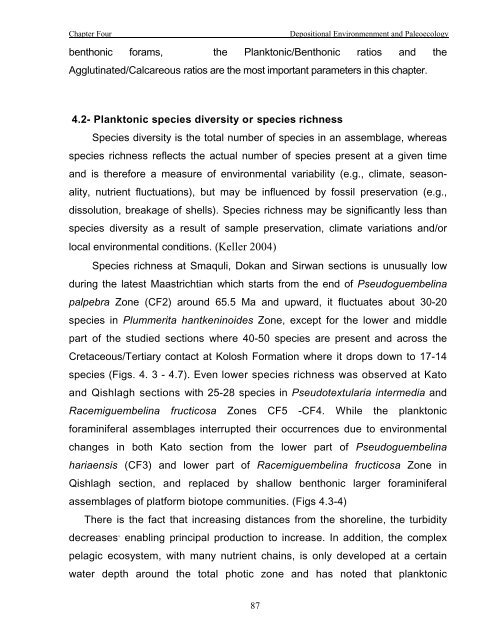biostratigraphy and paleoecology of cretaceous/tertiary boundary in ...
biostratigraphy and paleoecology of cretaceous/tertiary boundary in ...
biostratigraphy and paleoecology of cretaceous/tertiary boundary in ...
Create successful ePaper yourself
Turn your PDF publications into a flip-book with our unique Google optimized e-Paper software.
Chapter Four<br />
Depositional Environmenment <strong>and</strong> Paleoecology<br />
benthonic forams, the Planktonic/Benthonic ratios <strong>and</strong> the<br />
Agglut<strong>in</strong>ated/Calcareous ratios are the most important parameters <strong>in</strong> this chapter.<br />
4.2- Planktonic species diversity or species richness<br />
Species diversity is the total number <strong>of</strong> species <strong>in</strong> an assemblage, whereas<br />
species richness reflects the actual number <strong>of</strong> species present at a given time<br />
<strong>and</strong> is therefore a measure <strong>of</strong> environmental variability (e.g., climate, seasonality,<br />
nutrient fluctuations), but may be <strong>in</strong>fluenced by fossil preservation (e.g.,<br />
dissolution, breakage <strong>of</strong> shells). Species richness may be significantly less than<br />
species diversity as a result <strong>of</strong> sample preservation, climate variations <strong>and</strong>/or<br />
local environmental conditions. (Keller 2004)<br />
Species richness at Smaquli, Dokan <strong>and</strong> Sirwan sections is unusually low<br />
dur<strong>in</strong>g the latest Maastrichtian which starts from the end <strong>of</strong> Pseudoguembel<strong>in</strong>a<br />
palpebra Zone (CF2) around 65.5 Ma <strong>and</strong> upward, it fluctuates about 30-20<br />
species <strong>in</strong> Plummerita hantken<strong>in</strong>oides Zone, except for the lower <strong>and</strong> middle<br />
part <strong>of</strong> the studied sections where 40-50 species are present <strong>and</strong> across the<br />
Cretaceous/Tertiary contact at Kolosh Formation where it drops down to 17-14<br />
species (Figs. 4. 3 - 4.7). Even lower species richness was observed at Kato<br />
<strong>and</strong> Qishlagh sections with 25-28 species <strong>in</strong> Pseudotextularia <strong>in</strong>termedia <strong>and</strong><br />
Racemiguembel<strong>in</strong>a fructicosa Zones CF5 -CF4. While the planktonic<br />
foram<strong>in</strong>iferal assemblages <strong>in</strong>terrupted their occurrences due to environmental<br />
changes <strong>in</strong> both Kato section from the lower part <strong>of</strong> Pseudoguembel<strong>in</strong>a<br />
hariaensis (CF3) <strong>and</strong> lower part <strong>of</strong> Racemiguembel<strong>in</strong>a fructicosa Zone <strong>in</strong><br />
Qishlagh section, <strong>and</strong> replaced by shallow benthonic larger foram<strong>in</strong>iferal<br />
assemblages <strong>of</strong> platform biotope communities. (Figs 4.3-4)<br />
There is the fact that <strong>in</strong>creas<strong>in</strong>g distances from the shorel<strong>in</strong>e, the turbidity<br />
decreases , enabl<strong>in</strong>g pr<strong>in</strong>cipal production to <strong>in</strong>crease. In addition, the complex<br />
pelagic ecosystem, with many nutrient cha<strong>in</strong>s, is only developed at a certa<strong>in</strong><br />
water depth around the total photic zone <strong>and</strong> has noted that planktonic<br />
87

















